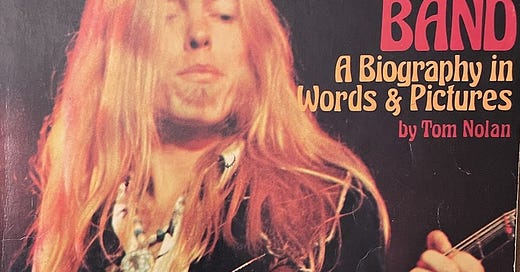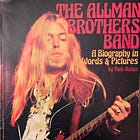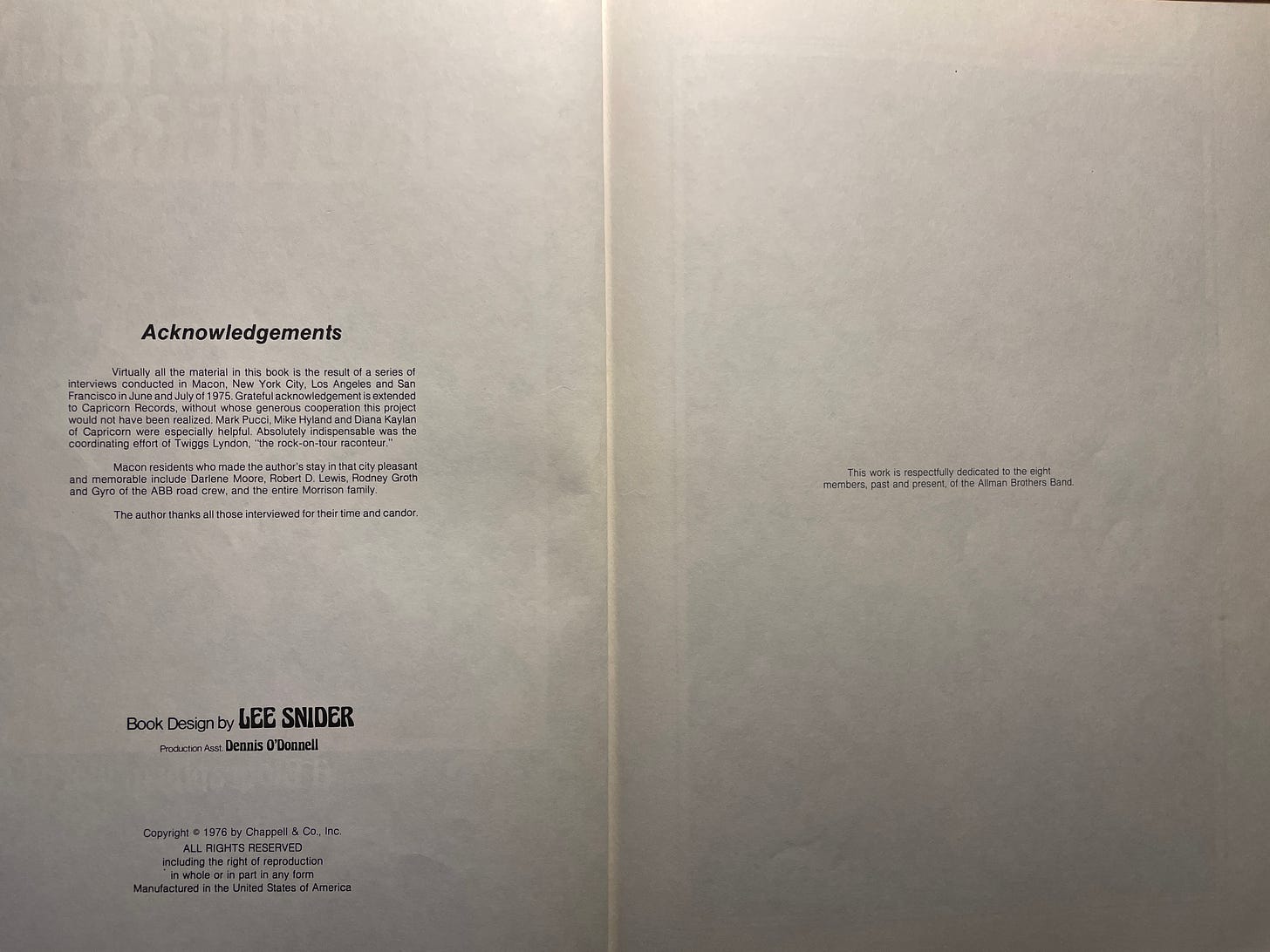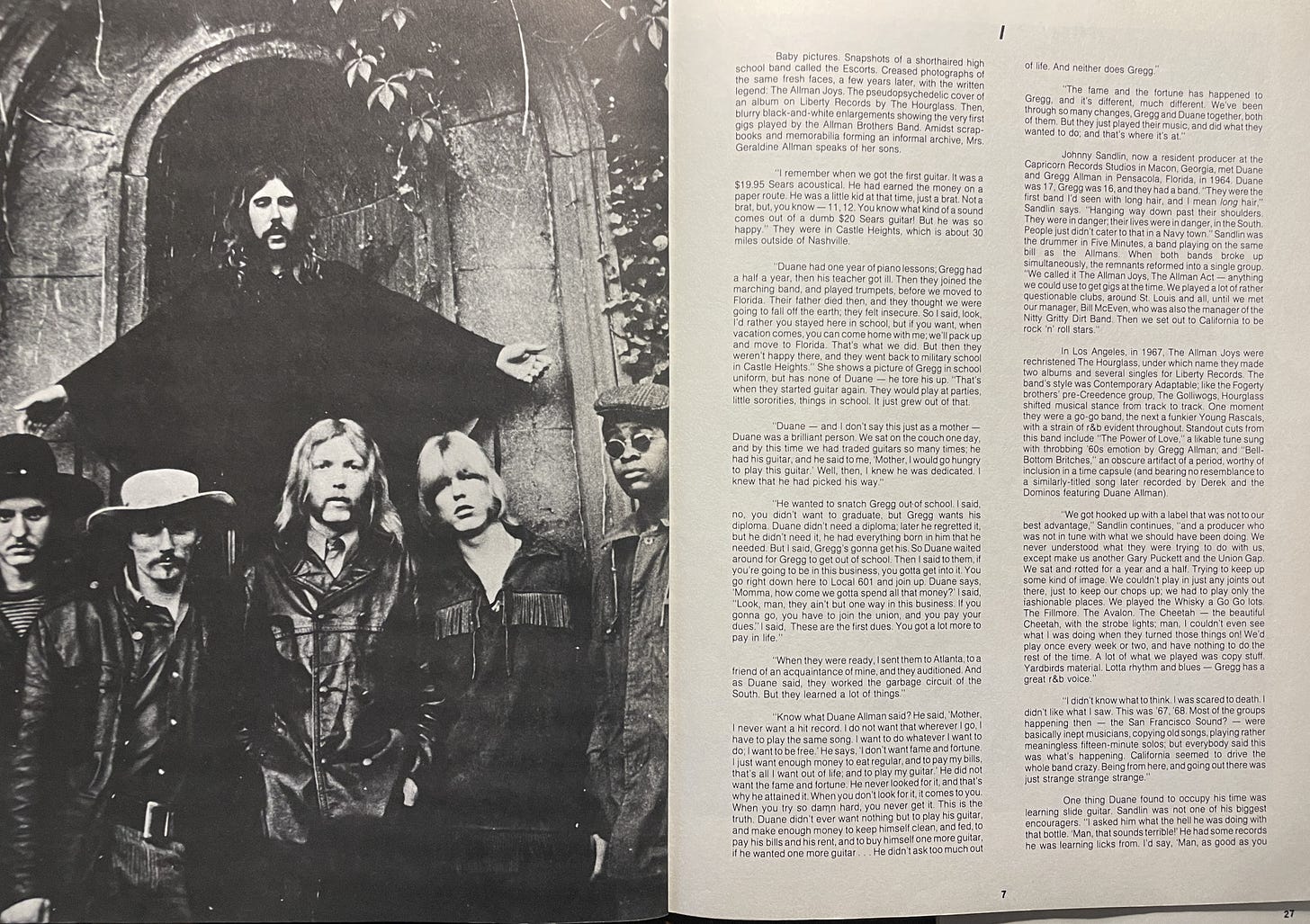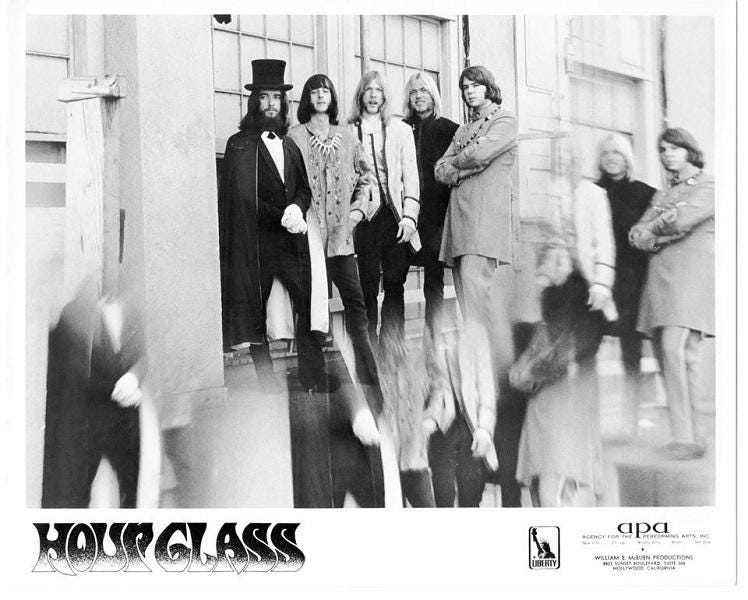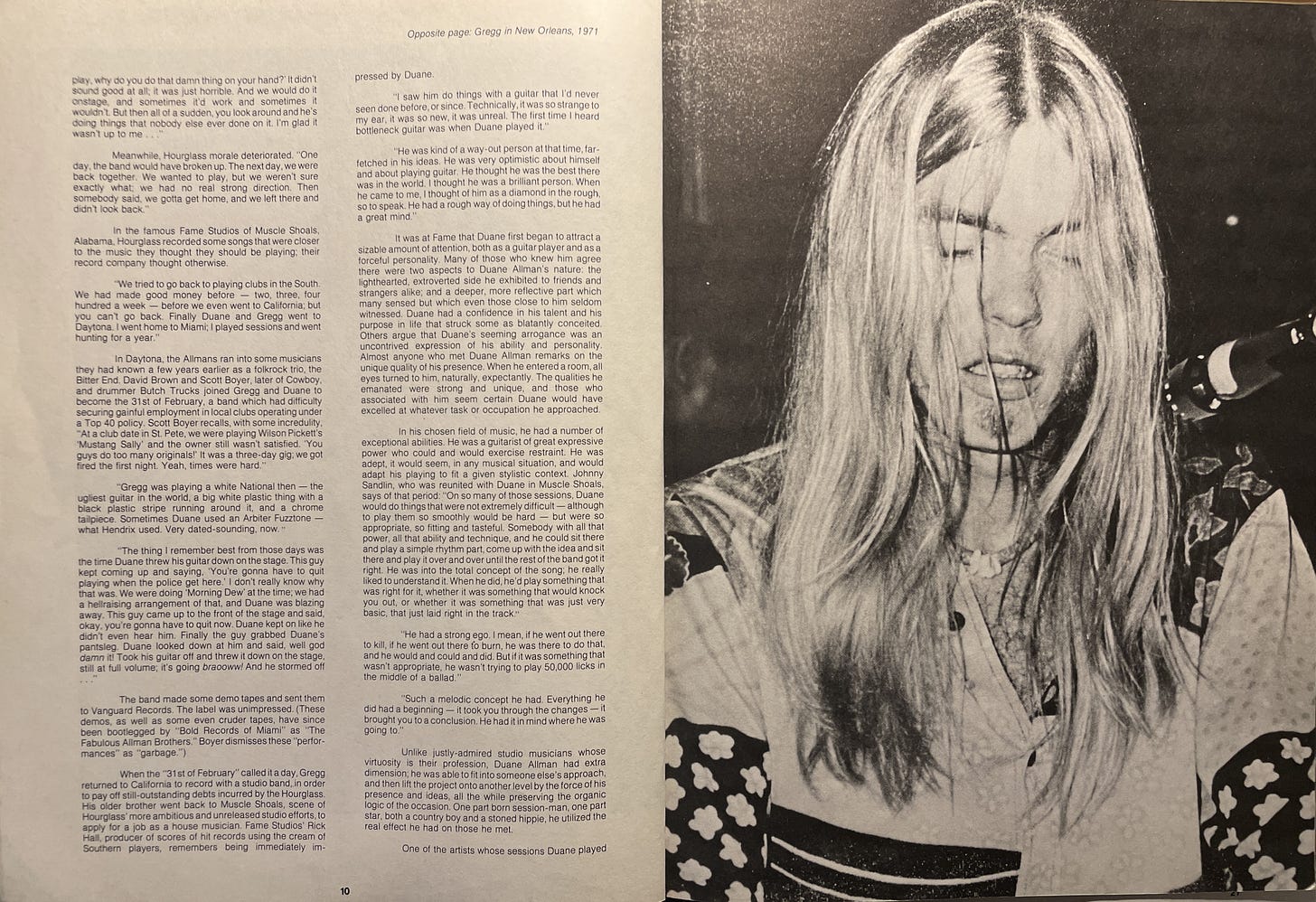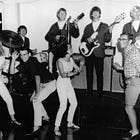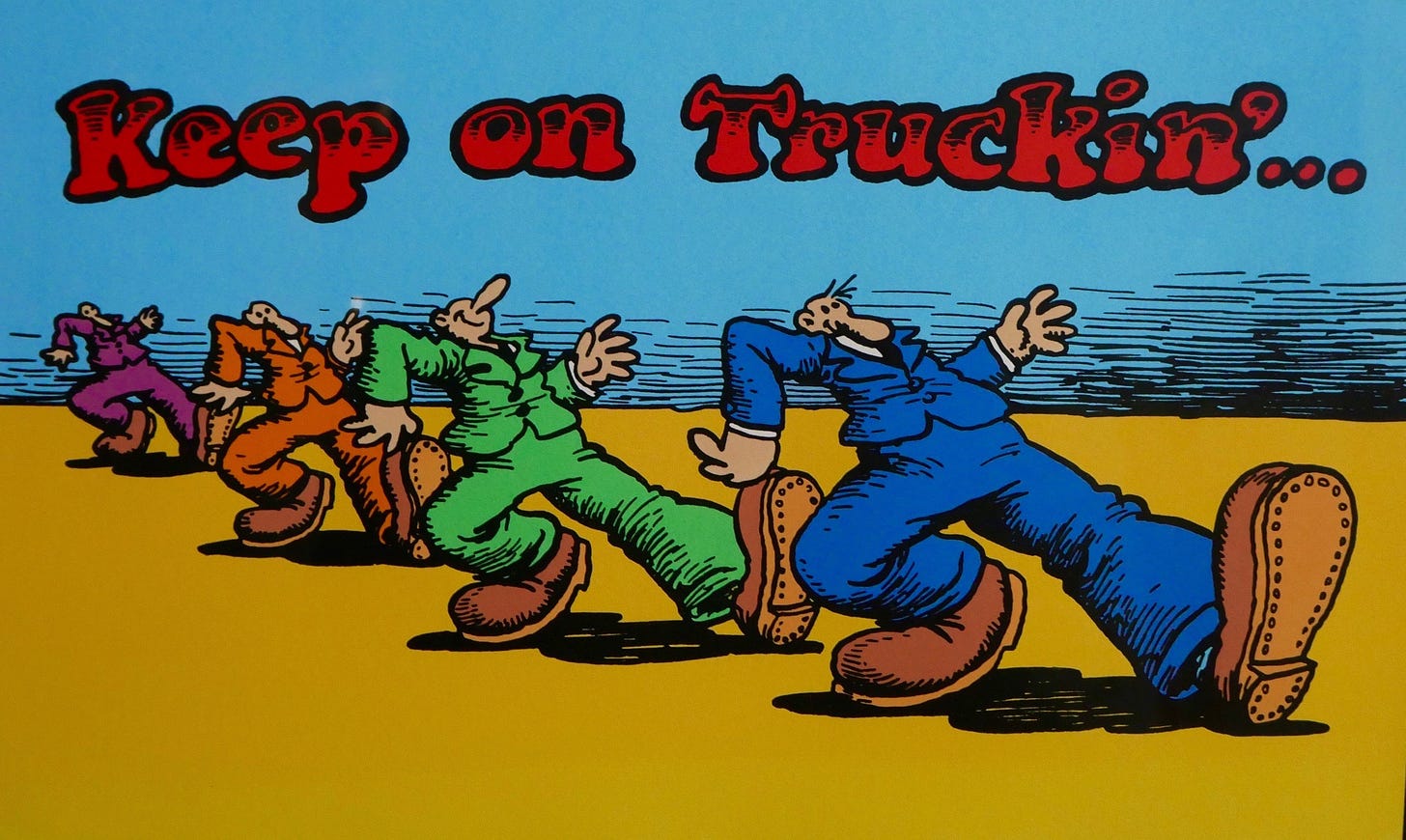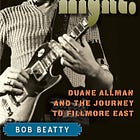Duane didn’t ever want nothing but to play his guitar, and make enough money to keep himself clean and fed
Revisiting the first Allman Brothers Band book
The quote above comes from Duane’s mother Geraldine Allman. It is from one of my ABBsolute favorite Allman Brothers Band sources of all-time: Tom Nolan’s The Allman Brothers Band: A Biography in Words and Pictures, a 1976 book published by Sire Books/Chappell Music Company.1
Long out of print, it first caught my attention sometime in the 1990s. I got my first copy from interlibrary loan.2 Even after Craig Ruskey of the Brother Duane Allman group on Facebook gifted me my own book, I kept the photocopies of it in a binder on my bookshelf for years.
It was a staple of my research for Play All Night!3 as it is the only full biography of the band until Scott Freeman’s Midnight Riders in 1995. The group hadn’t yet broken up when Nolan did his interviews and there’s a general sense of optimism throughout.4
It’s full of great quotes and has some of the early tellings of stories etched in Allman Brothers Band lore.5
I’m guessing some of y’all haven’t seen it before. It’s pretty long, so I’m going to serialize it here. I am making no changes or corrections. Where it’s wrong, I have left it wrong.
I’m including images of the actual pages 1-10 and a transcription. Here’s a full copy of the book:
Paid subscribers, keep an eye out for an annotated version later this week.
Acknowledgments
Virtually all the material in this book is the result of a series of interviews conducted in Macon, New York City, Los Angeles, and San Francisco in June and July of 1975. Grateful acknowledgment is extended to Capricorn Records, without whose generous cooperation this project would not have been realized. Mark Pucci, Mike Hyland, and Diana Kaylan of Capricorn were especially helpful. Absolutely indispensable was the coordinating effort of Twiggs Lyndon, "the rock-on-tour raconteur.”
Macon residents who made the author’s stay in that city pleasant and memorable include Darlene Moore, Robert D. Lewis, Rodney Groth and Gyro of the ABB road crew, and the entire Morrison family.
The author thanks all those interviewed for their time and candor.
Dedication
This work is respectfully dedicated to the eight members, past and present, of the Allman Brothers Band.6
Baby pictures. Snapshots of a shorthaired high school band called the Escorts.
Creased photographs of the same fresh faces, a few years later, with the written legend: the Allman Joys. The pseudopsychedelic cover of an album on Liberty Records by the Hourglass. Then, blurry black-and-white enlargements showing the very first gigs played by the Allman Brothers Band. Amidst scrapbooks and memorabilia forming an informal archive, Mrs. Geraldine Allman speaks of her sons.
“I remember when we got the first guitar. It was a $19.95 Sears acoustical. He had earned the money on a paper route. He was a little kid at that time, just a brat. Not a brat, but, you know - 11, 12. You know what kind of a sound comes out of a dumb $20 Sears guitar! But he was so happy.” They were in Castle Heights, which is about 30 miles outside of Nashville.
“Duane had one year of piano lessons; Gregg had a half a year, then his teacher got ill. Then they joined the marching band, and played trumpets, before we moved to Florida. Their father died then, and they thought we were going to fall off the earth; they felt insecure. So I said, look, I’d rather you stayed here in school, but if you want, when vacation comes, you can come home with me; we’ll pack up and move to Florida. That’s what we did. But then they weren’t happy there, and they went back to military school in Castle Heights.” She shows a picture of Gregg in school uniform, but has none of Duane - he tore his up. “That’s when they started guitar again. They would play at parties, little sororities, things in school. It just grew out of that.
“Duane - and I don’t say this just as a mother - Duane was a brilliant person. We sat on the couch one day. and by this time we had traded guitars so many times: he had his guitar, and he said to me, ‘Mother, I would go hungry to play this guitar.’ Well, then, I knew he was dedicated. I knew that he had picked his way.”
Duane - and I don’t say this just as a mother - Duane was a brilliant person.
“He wanted to snatch Gregg out of school. I said, no, you didn’t want to graduate, but Gregg wants his diploma. Duane didn’t need a diploma; later he regretted it, but he didn’t need it, he had everything born in him that he needed. But I said, Gregg’s gonna get his. So Duane waited around for Gregg to get out of school. Then I said to them, if you’re going to be in this business, you gotta get into it. You go right down here to Local 601 and join up. Duane says, ‘Momma, how come we gotta spend all that money?’ I said, “Look, man, they ain’t but one way in this business. If you gonna go, you have to join the union, and you pay your dues. I said, These are the first dues. You got a lot more to pay in life.”
“When they were ready, I sent them to Atlanta, to a friend of an acquaintance of mine, and they auditioned. And as Duane said, they worked the garbage circuit of the South. But they learned a lot of things.”
“Know what Duane Allman said? He said, ‘Mother, I never want a hit record. I do not what that wherever I go, I have to play the same song. I want to do whatever I want to do; I want to be free.’ He says, ‘I don’t want fame and fortune. just want enough money to eat regular, and to pay my bills, that’s all I want out of life; and to play my guitar.’ He did not want the fame and fortune. He never looked for it, and that’s why he attained it. When you don’t look for it, it comes to you.
“When you try so damn hard, you never get it. This is the truth. Duane didn’t ever want nothing but to play his guitar, and make enough money to keep himself clean and fed, to pay his bills and his rent, and to buy himself one more guitar, if he wanted one more guitar. He didn’t ask too much out of life. And neither does Gregg.
“The fame and the fortune has happened to Gregg, and it’s different, much different. We’ve been through so many changes, Gregg and Duane together, both of them. But they just played their music, and did what they wanted to do; and that’s where it’s at.”
Johnny Sandlin, now a resident producer at the Capricorn Records Studios in Macon, Georgia, met Duane and Gregg Allman in Pensacola, Florida, in 196[6]7.
Duane was 17, Gregg was 16, and they had a band. “They were the first band I’d seen with long hair, and I mean long hair.” Sandlin says. “Hanging way down past their shoulders.
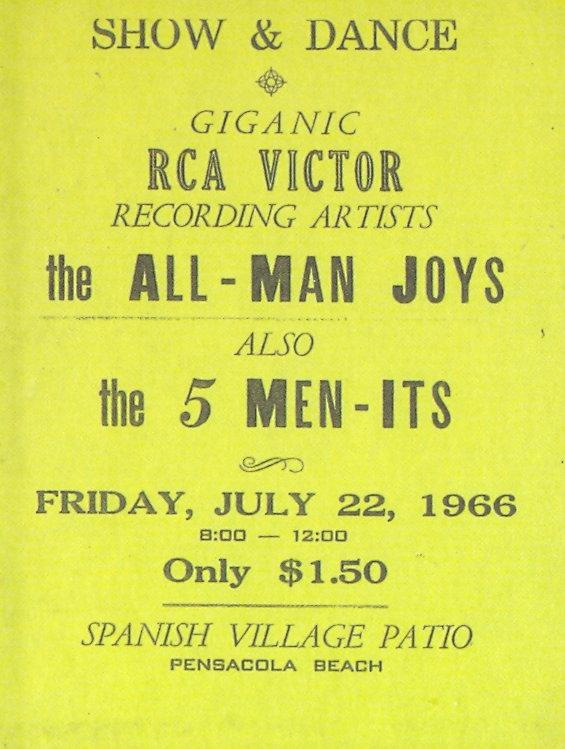
They were in danger; their lives were in danger, in the South.
“People just didn’t cater to that in a Navy town.” Sandlin was the drummer in Five Minutes, a band playing on the same bill as the Allmans. When both bands broke up simultaneously, the remnants reformed into a single group.
“We called it the Allman Joys, the Allman Act - anything we could use to get gigs at the time. We played a lot of rather questionable clubs, around St. Louis and all, until we met our manager, Bill McEven, who was also the manager of the Nitty Gritty Dirt Band.”
“Then we set out to California to be rock ‘n’ roll stars.”
In Los Angeles, in 1967, the Allman Joys were rechristened the Hourglass, under which name they made two albums and several singles for Liberty Records.
The band’s style was Contemporary Adaptable; like the Fogerty brothers’ pre-Creedence group, the Golliwogs, Hourglass shifted musical stance from track to track. One moment they were a go-go band, the next a funkier Young Rascals, with a strain of r&b evident throughout.
Standout cuts from this band include “The Power of Love,” a likable tune sung with throbbing ‘60s emotion by Gregg Allman; and “Bell-Bottom Britches,” an obscure artifact of a period, worthy of inclusion in a time capsule (and bearing no resemblance to a similarly-titled song later recorded by Derek and the Dominos featuring Duane Allman).
“We got hooked up with a label that was not to our best advantage,” Sandlin continues, “and a producer who was not in tune with what we should have been doing. We never understood what they were trying to do with us, except make us another Gary Puckett and the Union Gap.
“We sat and rotted for a year and a half. Trying to keep up some kind of image. We couldn’t play in just any joints out there, just to keep our chops up; we had to play only the fashionable places. We played the Whisky a Go Go lots.
“The Fillmore. The Avalon. The Cheetah - the beautiful Cheetah, with the strobe lights; man, I couldn’t even see what I was doing when they turned those things on! We’d play once every week or two, and have nothing to do the rest of the time. A lot of what we played was copy stuff.
“Yardbirds material. Lotta rhythm and blues - Gregg has a great r&b voice.
“I didn’t know what to think. I was scared to death. I didn’t like what I saw.
“This was ‘67, ‘68. Most of the groups happening then - the San Francisco Sound? - were basically inept musicians, copying old songs, playing rather meaningless fifteen-minute solos; but everybody said this was what’s happening. California seemed to drive the whole band crazy. Being from here, and going out there was just strange strange strange.”
One thing Duane found to occupy his time was learning slide guitar.
Sandlin was not one of his biggest encouragers. “I asked him what the hell he was doing with that bottle. ‘Man, that sounds terrible!’ He had some records he was learning licks from. I’d say, ‘Man, as good as you play, why do you do that damn thing on your hand?’ It didn’t sound good at all; it was just horrible. And we would do it onstage. And sometimes it’d work and sometimes it wouldn’t. But then all of a sudden, you look around and he’s doing things that nobody else ever done on it. I’m glad it wasn’t up to me.”
Meanwhile, Hourglass morale deteriorated. “One day, the band would have broken up. The next day, we were back together. We wanted to play, but we weren’t sure exactly what; we had no real strong direction. Then somebody said, we gotta get home, and we left there and didn’t look back.”
In the famous FAME Studios of Muscle Shoals, Alabama, Hourglass recorded some songs that were closer to the music they thought they should be playing; their record company thought otherwise.8
“We tried to go back to playing clubs in the South. We had made good money before - two, three, four hundred a week - before we even went to California; but you can’t go back. Finally Duane and Gregg went to Daytona. I [Johnny] went home to Miami; I played sessions and went hunting for a year.”
SOURCE: Tom Nolan,The Allman Brothers Band: A Biography in Words and Pictures (Sire Books/Chappell Music Company, 1976).
Stay Tuned
This part of the book truncates a tale that unfolds over multiple chapters in Play All Night.
Up next: the 31st of February, Duane’s first project to include a future Allman Brothers Band member other than Gregg, drummer Butch Trucks.9
For some musical context, here’s a couple playlists.10
Thanks for reading y’all.
Until next time…
I’ve never found much about this book series but the back cover advertises similar books on the Beach Boys, Elton John, Carole King, John Lennon, and Rod Stewart
Public libraries are already one of the greatest inventions in the history of the world. Interlibrary loan makes them even awesomer.
You know the drill, give the algorithm a tickle.
This is in contrast to Freeman’s interviews. Conducted in the 1980s after the band had broken up a second time, they reflect a frustration and weariness.
Here’s one I shared awhile back.
Eat a Peach was dedicated to Duane; Brothers and Sisters to Berry. They continued this tradition when they dedicated the Dreams box set to Duane, Berry, Twiggs, and Lamar.
This is the only thing I corrected. The book said 1964.
This session included “B.B. King Medley” that appeared first on Duane Allman: An Anthology (1972).
I created three mixes for Chapter 4 alone, I chose this one because Nolan focused on Hour Glass’s studio albums Here’s the masterlist of playlists ICYMI.

